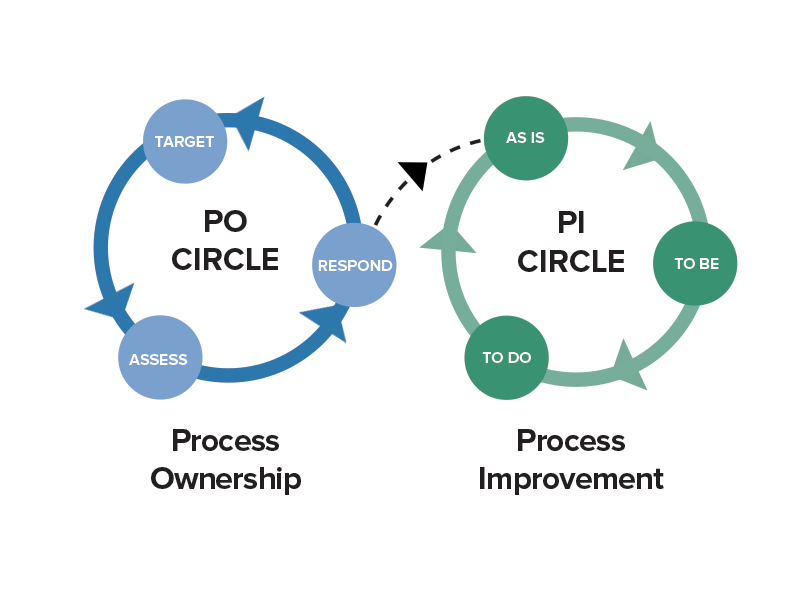-1.png?width=1024&name=Continuous%20Process%20Management%20l%20Quote%20(2)-1.png) Continuous process improvement is a common organizational aspiration, and it is one of the most difficult things an organization can attempt. The continuous aspect is quite a challenge, as is realizing business performance improvements—especially once the easy and obvious changes have been made. Organizations need an ‘internal improvement engine’ that replaces insistence with evidence.
Continuous process improvement is a common organizational aspiration, and it is one of the most difficult things an organization can attempt. The continuous aspect is quite a challenge, as is realizing business performance improvements—especially once the easy and obvious changes have been made. Organizations need an ‘internal improvement engine’ that replaces insistence with evidence.
Organizations need more than continuous process improvement; they also need continuous process management.
Continuous improvement
When it doesn’t deliver what it promises, continuous process improvement has two common failure modes: it’s not continuous, and there are few improvements.
However, it would be rare to find an organization that does not profess a belief in continuous process improvement.
While such aspirations are often genuine and many organizations act on them to realize performance improvements, if not continuously, then at least on a reasonably regular basis, the decision to select a process for analysis is too often tactical rather than strategic, ad hoc rather than deliberate.
Which process?
An important part of process performance analysis, perhaps the most important part, is deciding which process to analyze. Organizations have thousands of processes; where is the best return-on-process to be gained?
There are many reasons why a process might be selected for improvement analysis:
- The process is broken or causing problems, generating complaints
- A new idea needs to be tested and incorporated
- The operating environment of the process has changed
- Seems like an interesting thing to do
- The analysis is part of a regular review cycle
- It looks like a problem is developing in the process
- The capacity of the process to sustain possible change needs to be tested
These, and there will be others, are all good reasons to trigger a process analysis exercise. Most often, an actual or emergent failure triggers the analysis; the response is reactive and without the option for thoughtful assessment of where time and money should be invested to get the best result.
For as long as processes effectively choose themselves for performance analysis, there can be no certainty that performance is optimized.
Rapid may not be continuous
Frustration with the non-performance, or at least under-performance, of process-improvement projects over many years has understandably led to appeals for rapid process-improvement approaches of various kinds. The main thrust of these approaches is to make short, focused projects that will deliver change in a fixed timetable; for example, five or twenty days. Such projects that have minimum costs and maximum return are a welcome change from projects that take a long time, cost a lot, and deliver little.
However, rapid doesn’t necessarily mean continuous. Focused, effective process-improvement projects are a significant improvement, but they are not, alone, a systematic approach to continuous improvement.
Continuous management
To remove the role of serendipity and avoid ad hoc decisions about process improvement, we need an added layer of continuous process management.
Organizations need to create a systemic approach, where an unflagging search for problems, opportunities, and genuine continuous improvement, will deliver a better performance improvement result than reactive or ad hoc analysis.
The objective needs to be an unrelenting cycle of efficient and effective projects based on a constant, proactive search for process-improvement opportunities. Organizations need an ‘improvement engine’ at the center of their performance management efforts.
To achieve continuous process management, the organization first needs to be visualized as a hierarchical set of interconnected business processes—a process architecture. Then, starting at the top and working down at least two levels, each process needs to be assessed as to its target and current performance against well-chosen measures (KPIs). Evidence-based decisions can then be made about which processes should be improved, and in which order across the process architecture.
Elsewhere on this site, I have written in detail about the Tregear Circles (below), a metamodel for continuous process management and improvement. The PO circle has three nodes: target, assess, and respond. Target–assess–respond is the essential cycle of process-based management. Identify a process and set a performance target, assess actual performance, and respond if intervention is warranted for any of three reasons: to change the target, to address a performance anomaly, or to test a new idea. In the second and third cases, the PI circle is triggered, while the PO circle keeps turning. This is the main game; all process management and process improvement comes down to this.

Continuous process improvement AND management
To optimize the return on the considerable investment in continuous process improvement, it is important to also invest in continuous process management.
Mindfully making informed decisions about which processes need attention, rather than allowing them to self-select by squeaking the loudest, will significantly improve the return-on-process.




